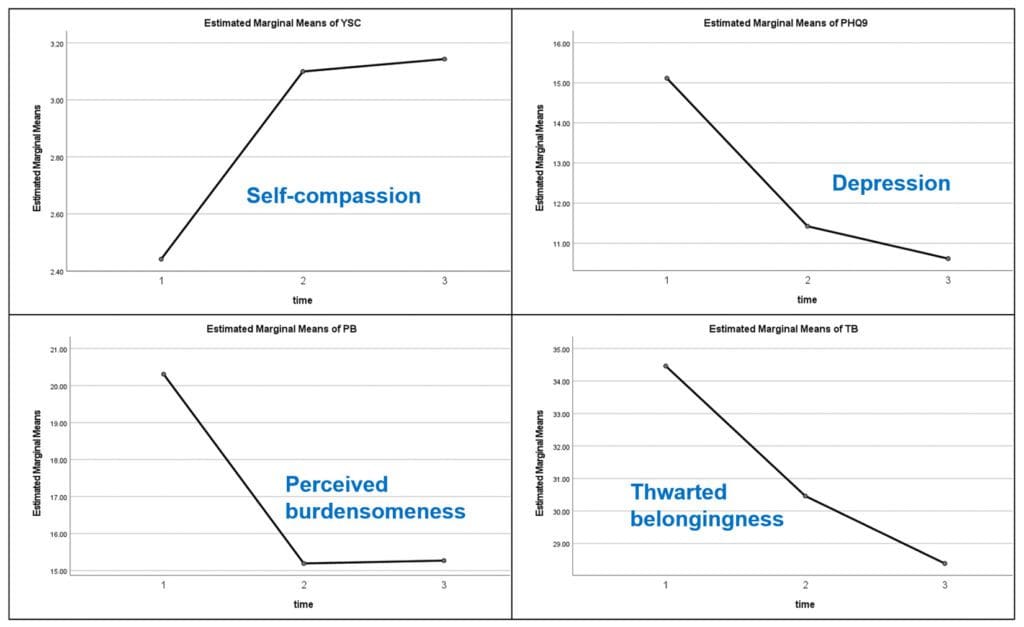
This piece by Karen Bluth, PhD is part 2 of an article honored with the 2022 Mind & Life Institute Award for Public Communication of Contemplative Research and was originally featured in Psychology Today online. Part 1 explained what self-compassion is and its role in improving teen mental health outcomes. But how can self-compassion be taught, and how can more young people benefit? These questions are explored in part 2.
In 2013, Kristin Neff and Chris Germer published the results of a study of their newly developed program called “Mindful Self-Compassion.” This program for adults was eight weeks long with participants meeting for two and a half hours once per week, with a four-hour retreat session around the fifth week. The program had a foundation of mindfulness but focused on cultivating self-compassion through guided meditation practices, exercises, some didactic teaching, and inquiry in which teachers guided participants to explore their inner experience during practices.
Results showed that self-compassion could be learned—compared to a control group, participants who were in the Mindful Self-Compassion group had significantly greater increases in self-compassion, as well as significant improvements in anxiety, depression, how compassionate they were toward others, and how satisfied they were with their lives. Moreover, improvements in self-compassion were maintained a year later.
Could the same thing be true for teens? Could teens also learn how to be more self-compassionate, thereby gaining a resource that would help them cope with the challenges they face? In 2014, my colleagues and I began working on an adaptation of Mindful Self-Compassion, originally called Making Friends with Yourself (recently changed to Mindful Self-Compassion for Teens). Compared to the control group, participants in the self-compassion group reported significantly greater self-compassion, greater satisfaction with their lives, and less depression at the end of the program. Since then, other studies have found similar results when teaching self-compassion to teens.
Most recently, my colleagues and I conducted a study with transgender and gender-expansive teens, a population that struggles with high depression and suicidal behavior. In fact, transgender teens are four times more likely to be depressed compared to their cisgender (nontrans) peers; about half of these teens seriously consider suicide, and a third of them attempt suicide. In this study, Mindful Self-Compassion for Teens was taught virtually over Zoom in eight 90-minute sessions, and assessments were taken before and after the program, and again three months after the program was over. Teaching over Zoom made it possible for teens all over the United States and Canada to participate.
Although suicidal thinking and suicidal behavior were not directly measured in this study, two factors closely related to suicide behavior were measured: thwarted belongingness and perceived burdensomeness. Thwarted belongingness assesses the degree to which the teens felt that they tried to belong and be accepted to a group but were rejected, and perceived burdensomeness assesses how much the teen felt that they were a burden to others. When both these factors are present to a high degree, it is likely that the teen thinks about suicide.
Results of this study were very encouraging. Not only did self-compassion improve significantly from before to after the study with changes maintained at follow-up, but teens also reported significant improvements in depression, anxiety, resilience, satisfaction with life, and perceived burdensomeness. Three months later, teens also reported significant decreases in thwarted belongingness (see Figure 1).

Where Do We Go From Here?
We know that being self-compassionate has clear benefits for teen mental health and well-being. We know that it protects teens from not only the challenges that they have always faced, such as exploring new identities and figuring out what they value and believe in, but also some of the difficulties particular to this moment in history, such as social media and its negative outcomes for teens and academic pressure.
We also know that it’s possible to “grow” your self-compassion through programs and practice. The pressing question then is this: How can we reach more teens, beyond those whose parents have the financial means to fund their child’s self-compassion course?
Meeting Teens Where They Are
We found it’s best to go where most teens are—the classroom. Ideally, self-compassion programs could be offered in school settings and ultimately become an integral part of the school curriculum. Programs could be offered as a unit within a health class or in shorter sessions throughout the school year, perhaps in homeroom as a schoolwide initiative. It would be essential to train teachers in self-compassion as well, so they could reduce their own stress levels and model self-compassion for students, as well as support students in their own self-compassion practice. School support staff, such as cafeteria workers, bus drivers, front office staff, teacher aides, and custodians could also benefit from learning self-compassion tools.
Of course, families are part of the school community as well, and parents and caregivers could learn how to be more self-compassionate while simultaneously facilitating self-compassion development in their children. A school culture where everyone has better coping resources and would therefore be better able to support each other would undoubtedly be a community where health, flourishing, and academic achievement prevailed.
In short, there are endless ways to expand our reach in bringing self-compassion to youth. What is most important is that we do so without delay. We know from extensive research that self-compassion helps to alleviate suffering. Now, we need to confront the reality that our teens are suffering, and take the necessary steps to provide them with the coping resources that we know work, so that they can move beyond their own pain into a future of well-being and health.
Karen Bluth, PhD is an Associate Professor in the Department of Psychiatry and a Research Fellow at the Frank Porter Graham Child Development Institute at the University of North Carolina at Chapel Hill. She is the Associate Editor of the journal Mindfulness and the author of The Self-Compassion Workbook for Teens. Karen was the recipient of a 2012 Mind & Life Francisco J. Varela Grant.

